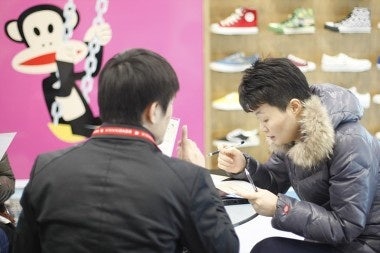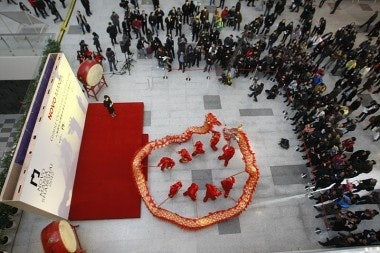Novomania International Fashion Trade Show Recently Wrapped In Shanghai#

With an ever-increasing number of large mid-range retailers, from J. Crew to Abercrombie & Fitch, poised to enter the China market via Hong Kong in 2012 and 2013, and China retail sales expected to rise 15 percent this year, smaller brands are turning to trade shows in cities like Shanghai to test out the waters. Absent the financial means to cultivate local connections or get a sense of real estate or branding concerns in first- and second-tier Chinese cities, urban trade shows like the recently concluded Novomania are proving an asset to brands that have strong followings in Europe or North America but are just now being enticed to Asia or, more specifically, mainland China.
Wrapping earlier this month, this year's Novomania attracted around 150 exhibitors and around 13,000 visitors. Among the brands exhibiting were Superdry, Replay, American Vintage, Custo Barcelona, DKNY Jeans, Liebeskind, WeSC and Calvin Klein Jeans. While some, such as Calvin Klein and DKNY, are no strangers to the mainland China market, others, such as the French brand American Vintage -- which opened its first Asia location at Hong Kong IFC last autumn -- and the British company Superdry currently reach mainland Chinese consumers via locations in Hong Kong.
According to Guilherme Faria, Novomania General Manager, “A lot of the brands that participated in Novomania 2012 are looking for the best way to enter China," adding that trade fairs let brands "get real feedback from the Chinese fashion market, driven by retailers and real estate developers.” Faria noted that a great deal of a brand's China entrance strategy hinges on its understanding of the country's real estate market -- a factor that has impacted the expansion plans of many brands, as they've butted up against high rents and unsuitable retail space (especially in inland cities). Said Faria, "For the second consecutive year Novomania partnered with the global real estate group Savills to invite China’s top developers to exhibit and hold panel discussions, seminars, presentations, and casual cocktail gatherings."

For brands with an established retail presence in China, trade fairs like Novomania are used more for putting on fashion shows aimed at the country's nascent group of fashion buyers. At this year's event, brands like Mango and Tom Tailor mounted runway shows. As Marc Schumacher, Chief Retail Officer at Tom Tailor, said at the event, "For us, it's a great opportunity to figure out the best way in which to partner up and enter the Chinese market.”
While trade shows will likely be a good way for smaller brands to gauge potential Chinese interest in their products, as Hong Huang noted in her WWD ChinaFile column this week, sinking too much money or time into attracting Chinese fashion buyers might remain a futile task. Writes Hong:
Chinese fashion retailing does not have buyers. Department stores are landlords who lease space to brands. There is no buyer system in China. So if you join China Chic and do a runway show, its only benefit is media exposure and branding. No real orders will come from the show. The few stores that might buy are so small in scale they will not be able to float even the smallest fashion design studio.